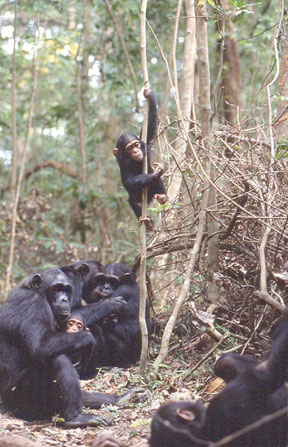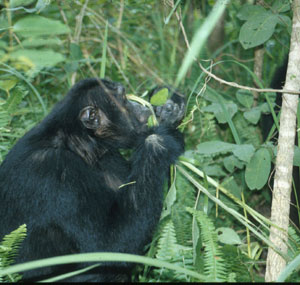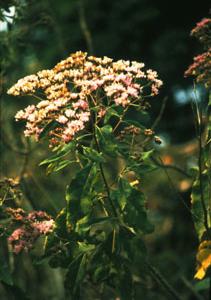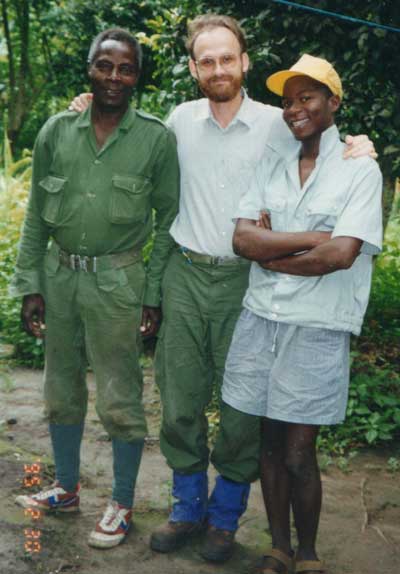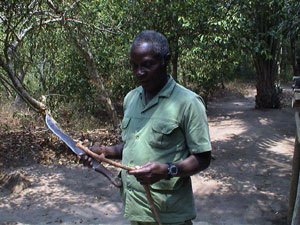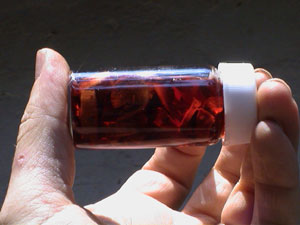|
(Book cover design) Representation of the multi-disciplinary nature of this research, integrating field and laboratory work. Overlaid on a photo of the Mahale Mountains, Tanzania, where the majority of the work described in this publication was conducted, are the three representative Mahale chimpanzee self-medicative behaviors, bitter-pith chewing, whole leaf swallowing and geophaby (left to right, top to bottom). Mirrored to the right (right to left, top to bottom) are the major representative bioactive compounds from Vernonia amygdalina associated with bitter-pith chewing, the strongyle nematode Oesophagostomum stephanostomum, the recognized stimulus for both bitter pith-chewing and whole leaf swallowing at Mahale, and an SEM photo of the rough, hispid surface of Lippia plicata, one of the several species swallowed whole and responsible for expelling these nematodes. |
Papers by Index number (see below) *C.H.I.M.P.P. stands for 'Chemo-ethology of Hominoid Interactions with Medicinal Plants and Parasite'. In the winter of 1991, this acronym for our budding research consortium (The C.H.I.M.P.P. Group) was conceived. Sitting out on the sandy beach of Lake Tanganyika on a calm evening just before dusk watching the sun set on the other side in Congo, Hajime Ohigashi, Koichi Koshimizu and I were celebrating another successful day with Mohamedi out in the forest collecting Vernonia amygdalina and other medicinal plant species to take back to Kyoto for analysis. For better or worse, we were inspired, or inspirited perhaps is more descriptive, by an incredible bottle of homemade sparkling pineapple wine, given to us by Edeus Massawe, the then acting director of the Mahale Mountains Wildlife Research Center. Thank You Eddy! |
The following compilation of scientific research papers and articles is the result of the first 18 years of fruitful collaborations from people of many nations, ideologies and cultures. These collaborations have provide not only new insights into the wonder of nature's complexities, but has personally been a rewarding path to the understanding of the absolute necessity and importance of the multidisciplinary approach and of the significance of cultural diversity in science. Science is indeed the universal medium of our collaboration, but no single country or discipline was more important than the others. More than anything else, I am grateful to all who have shared in this work for their enduring friendship and graciousness. For the results compiled here would not have been possible had it not been for their overwhelming generosity in the sharing of valuable expertise, time and resources. Their names are too many to mention, but the majority of them appear in the following papers that make up this document. Given the diversity of disciplines which have been involved in this research, key collaborators from the beginning, and treasured friends, Hajime Ohigashi, Koichi Koshimizu and I have thought for some time that is was necessary to put the growing number of papers together into one volume, not only to provide a near complete record of this work, but to provide access to papers published in journals that no single reader would be familiar with or would not normally come across in the literature of their own discipline. Admittedly there is overlap in some of the review papers, as they were written on request or where published as proceedings of a variety of different academic societies and congresses inviting us to share our research with them. In spite of this overlap and the expense of weight, I have included most of them here to provide as close of a complete record of our activity as possible. There is still so much to do, as we have really only
begun to scratch the surface. In collaboration with students
and colleagues from around the world, we have begun to
compile a database of the feeding lists of representative
primate species ranging from prosimians in Madagascar,
monkeys of the Neotropics and Asia to the great apes of
Africa and Southeast Asia. From this we have begun to assess
through the literature, and our own research, the
complimentary nutritional and medicinal properties of 'food'
and its importance in primates in an attempt to expand our
understanding of the breadth and depth of self-medication
and health maintenance behaviors and to identify promising
new animal and plant targets for research. It is our strong
desire that this document encourage those who read it to
pursue this line of research and to expand it above and
beyond what we have done. The printing of this document was made possible through
research funds provided to Michael A. Huffman (基盤C16570193)
from the Ministry of Education, Science, Sports, and
Culture, Japan. My warmest appreciation goes to Fumie Naito
and Reiko Nagata for their kind help in scanning many of the
papers included here within onto PDF files, which made the
final printing easier. Any mistakes or omissions are solely
my responsibility.
November 21, 1987, 4.50 am: The booming pant-hoots of a lone chimpanzee break the pre-dawn stillness and wake me from a comfortable sleep. It is still nighttime in Mahale, but the sun has already begun to rise over the Indian Ocean on the Tanzanian coast some 1000 km to the east, poised to begin its push across the expansive savannah woodlands of the interior. The rays of early morning light will not reach Kansyana camp for at least another hour and a half. The Mahale Mountains are the last hurdle that the sun must overcome before its welcome warm rays finally cover all of Tanzania.
Over the next two hours, the lone male urgently continues to
call out in hope of getting a reply from his scattered
companions. Typical of Mahale chimpanzees during the rainy
season, they have begun to split into smaller groups in
search of limited patches of food. Now, at the beginning of
the rainy season members of the Mahale M-group are not
always so easy to find. At around 7:50, Mohamedi Seifu Kalunde, my friend and research assistant, arrives at camp coming from Kasiha village. We waste no time and head north in the same direction as Ntologi did. The first hour is spent moving north and just climbing up the steep slopes of the mountain to a high vantage point on the ridge where we are most likely to hear chimpanzees in the Mpila river valley-basin down below. At 9:36, during our traverse of the forested G-ridge, we again hear the familiar series of pant-hoots from a single male. Almost instantaneously thereafter, his pant-hoots are met by a rally of replies in kind from a small party further up the river, followed by yet another small group still further up the mountain. From their calls, we know that the chimpanzees are split into small groups spread all across the forest, probably in search of fruits. As quickly as they announce their presence, they are they swallowed up once again in the silence within the thick dark green landscape. Between 9:50 and 12:41, we find several individuals and begin to record their behavior, noting who is in the group, what they are feeding on, which females are sexually receptive and so on. This basic data has been accumulated on a daily basis since 1965 when the research first started. Moshi Bunengwa, another of our team's research assistants, comes with the news that he has seen Ntologi who is now traveling with two young males, Nsaba and Hito. Like ourselves, Ntologi has successfully made contact with other group members. Alone or in small groups, chimpanzees sit quietly in the canopy or hang one-handed from branches, plucking out the red wax-membrane coated seeds of Lulumasia, a relative of the nutmeg, from the thick yellow husks clustered together like grapes. We first detect this small party of chimpanzees only from the sound of discarded husks falling to the ground with a light thud. Chimpanzees on the ground are even harder to spot but they can be heard as they pull up stalks of Itungulu--African ginger or Iswe--elephant grass. Sometimes also protruding out of the ground at the base of the stalks are the oblong red fruits of Itungulu, a welcome treat for chimpanzees and humans alike. Throughout the morning, individuals join and split from the group we are watching. At 12:41, Mohamedi and I hear a round of pant-grunt greetings and screams in the distance. We intercept the group as they descend along the Mpila River. We find a group of eleven individuals including two adult males, Lukaja and Kasangazi, the then young adolescent male Jilba, three adult females Chausiku, Wantendele and Wakilufya and their four dependent offspring Chopin, Masudi, Maggy, and Ashula.
The three adult females, all immigrants from the now extinct Kajabala-group often travel together when not sexually receptive. They have continued their friendships and help watch over each other's young in Mimikire-group. They, no doubt, find solidarity amongst themselves in a society where newcomer females are harassed by more dominant females in competition for valuable food resources and possibly mates. Wantendele, Wakilufya, and the adult male Lukaja are three of the target individuals in my study this season. Mohamedi and I begin our real work for the day at last. We start by following Lukaja, the lead member of the group as he quickly moves down the river-bed-obstacle-course of large slippery boulders in the Mpila riverbed. The rest of the chimpanzees follow closely behind. Lukaja and his two male companions are lost after only 16 minutes of contact. They leave the females behind as they double back and disappear into thorny dense bush in the direction of pant-hoots from a larger group up on the ridge the same place from where we first heard chimpanzees calling this morning. We continue to follow the females as they quickly move into the forest then pause to listen to the large group up on the ridge. They decide not to follow and begin to move at a leisurely pace in the cool shade of the trees, in search of something to eat. With extremely acute vision, Wantendele spots a cluster of ripe yellow Ilombo fruit high in the canopy. She swiftly climbs up with Maggy clinging to her back. Her son, Masudi continues to wrestle with Ashula and Chopin on the ground. Chausiku climbs up only a short distance and rests. A hunch tells me that Chausiku does not seem to be feeling well. She constructs a sturdy daybed by weaving live branches into a stable platform in the fork of a large branch. She listlessly stares up into the canopy at her two-and-a-half-year-old son, as he precariously dangles from a branch by one hand. Masudi and Maggy tug at his feet in an attempt to solicit play. If a young infant fell from such a height, it could easily be injured. A mother is usually nearby to retrieve her infant and scold its older playmates, but today Chausiku pays no attention. She appears weak and lacking in energy. By 13:2,0 our initial group of eleven has dwindled down to only two adult females, Wantendele and Chausiku, and their three offspring. At 13:22, Wantendele moves south with Maggy and Masudi to feed on figs and more Ilombo. Mohamedi and I decide to follow them. Wantendele doubles back and returns to the base of the same tree where we left Chausiku 30 minutes earlier, as if she expects her to still be there. She is and has not budged from her bed. Chopin continues playing alone higher up in the branches. At 14:02, Chausiku climbs down to the ground and meets Wantendele who has patiently been waiting for her. They all start to move south. Chausiku's progress is painfully slow as she frequently stops to rest. The others continue on ahead, pausing occasionally to feed on the pith of Iswe and Itungulu, always remaining in sight of Chausiku. At 14:13, Chausiku goes directly to and sits down in front of a shrub and pulls down several new growth branches about the diameter of my little finger. She places them all on her lap and removes the bark and leaves of the first branch to expose the succulent inner pith. She then bites off small portions and chews on each for several seconds at a time. By doing this, she makes a conspicuous sucking sound as she extracts and swallows the juice, spitting out most of the remaining fiber. This continues for 17 minutes, with short breaks as she consumes the pith of each branch in the same manner. Not being familiar with this plant, I ask Mohamedi, as we continue to watch Chausiku, what it is called in the local Tongwe vernacular. He replies, "Mjonso". Mohamedi has worked here with the Kyoto University chimpanzee research project since it started in the early 1960s and is widely acknowledged by researchers and fellow Tongwe tribesman for his vast knowledge of the flora and fauna in the area.
While Chausiku continues to feed, Wantendele sits nearby feeding on Iswe but shows no interest in the Mjonso. Chopin does seem interested, however, and begs for a piece of pith hanging from his mother's mouth. He picks up a piece, which falls from her mouth and a section of the discarded leaf and bark from the ground. After putting these things in his mouth for a brief second he quickly discards them and continues chewing on a piece of Iswe. Not having seen chimpanzees eat this plant before, I next ask Mohamedi if chimpanzees consume it often, and add that I have not seen them show any interest in it before today in my ten months of observations here. He nods and replies that, indeed, it is not eaten frequently. He adds that K-group chimpanzees also ate the pith, but that chimpanzees probably do not eat too much because it is very bitter. Interested in the customs and material culture of his people, I next ask him if the Tongwe use it for anything. He smiles and says matter of factly, "Yes, it is very strong Dawa (medicine)." "What kind of Dawa?", I ask in amazement. He replies saying it is most commonly used for malaria-fever, stomachaches, and intestinal parasites. My mouth drops open as the details of our observations of Chausiku over the last hour and a half flash through my mind. I become consumed with an urgency to know just what the outcome of Chausiku's behavior will be and I am filled with a rush of adrenaline. Without speaking, we agree that we will follow and watch her closely. As time progresses, the severity of her illness becomes more apparent. Her lower back appears painful because of the careful and slow way she walks, sits down and climbs trees. She is also weak and has little appetite. At one point we also note the unusually dark color of her urine as she relieves herself off the side of her daybed. Wantendele does not leave Chausiku for the remainder of the day as they slowly make their way south to the northern foot of G-ridge. At 15:01, Wantendele climbs up into a Lwago tree and feeds on its fruits. Chausiku slowly and with obvious effort climbs up and makes a new daybed below Wantendele. Thirty minutes later, Wantendele climbs down and sits on the ground. Chausiku raises her head, then slowly moves out of her bed and climbs partway down the tree, but stops and builds another daybed. After a few minutes of hesitation, Wantendele climbs back up into the tree and builds a daybed herself at 15:33; she remains there until Chausiku finally comes down at 16:49 after another long rest. Once again they set off south and Chausiku follows but quickly begins to lag behind the others. After several stops, a drink of water and brief nibble on ginger pith, Chausiku catches up with the others at 17:29. Wantendele, Maggy, and Masudi have already climbed up into the trees for the night. Chopin sits waiting on the ground for his mother to arrive. In a last struggle, Chausiku slowly climbs up into a tree and builds her last bed for the day at 17:44. Chopin climbs high up into the tree and explores on his own. We stay with them until around 18:00 then head back to camp before it gets too dark. On several occasions today we had the impression that Wantendele coordinated her activities to keep an eye on Chausiku. The main group was occasionally within hearing distance and probably less than a mile from us all afternoon. Nonetheless, Wantendele made no attempt to leave her friend to join them. Back at camp, our story is met with both excitement and disbelief by some of the senior members of our research team. They had, of course, seen chimpanzees use this plant, known by its Latin name as Vernonia amygdalina, but had neither associated its use with sickness nor were they aware of the plant's medicinal value to the Tongwe. Their healthy skepticism encourages me even more strongly to follow this through to the end. The next morning between 7:00 and 8:00, a small group of three to four chimpanzees pant-hoot on the mountain side Southeast of camp, as they find their first meal of the day. Mohamedi and I head north. By 9:00 we make contact with our first group of eleven chimpanzees. To our joy we find Chausiku and Wantendele with them, only 60 meters from where they made their beds last night. Besides Chausiku, Wantendele and their offspring, included in the group is the higher ranking adult male, Kalunde, the adolescent male Jilba, a recent immigrant, the young adult sexually receptive female Patty, and another adult female Gwekulo (born ca. 1962 in K-group). Today Gwekulo seems to have the job of looking after Chopin. This is not the first time for Gwekulo to watch over Chausiku's infants in times of sickness. Such associations are known as 'baby-sitter relationships' in which young adult females travel together with a particular mother-infant pair and act as a playmate for the infant and a travel companion for the mother. When these young females are sexually receptive, however, they usually travel within groups, which also contain males. Gwekulo never had the luck to have children of her own. Thus, even nowadays she very often moves around with other females and their offspring. While Chausiku is lying down off to the side of the group, Gwekulo sits nearby Chopin, watching over him as he wrestles with Ashula and Masudi. Occasionally, Patty solicits Chopin to copulate. At 9:59, the group moves south. Chopin follows after Patty. Chausiku slowly follows behind the group for less than a minute before she separates from Chopin and the rest for the next 38 minutes. She still appears quite weak, frequently stopping to sit and rest. At 10:42 she is seen to eat for the first time today. Chopin is now traveling with his mother again and between 11:03 and 11:31 they slowly follow behind the group feeding on small amounts of Kasolyo figs and Lulumasia. Chausiku catches up with the rest of the group and they all stop for their habitual midday nap. At 12:49, after a long 72 minute sleep, everyone awakens in a commotion of pant-hoots and screams as if a fire station alarm had just gone off in the middle of the night and is up and on the move. Mohamedi and I are caught off guard. As they disappear into the tangle of thorny vines, we crawl on hands and knees, sometimes squirming on our bellies, to keep up with them. At 13:06, we succeed in getting through the worst of it to find the group nonchalantly resting again. Chausiku, Chopin, and Gwekulo, however, immediately get up and leave the rest of the group behind as they head southwest. Following behind at a half running pace just to keep up with Chausiku, it becomes clear to us that her condition is improving. She pauses occasionally, this time looking behind her, to see if the others are keeping up. Chausiku seems irritable and distracted, slapping the ground and grunting when Chopin refuses to follow close behind. Gwekulo stays behind to wait for Chopin to catch up while Chausiku continues to move on ahead. Finally at 13:51, they all end up in an open semi-swamp grassland area filled with three to four meter high elephant grass. Chausiku continues to eat steadily, consuming the succulent pith of elephant grass and ginger, the small semi-sweet red figs of Kankolonkombe and the tangy baseball-sized yellow fruits of Ilombo. We terminate our observations at 16:05, when we can no longer keep up with her. What Mohamedi and I witnessed over these days was to be the beginning of a study that has continued for the last decade. Since this time we have observed other sick individuals consume the bitter pith of Mjonso and we have found still other plants like Aspilia that may be used in other ways as medicine by these chimpanzees. The production of toxins, drugs and other compounds, called secondary metabolites by the chemists who study them, is considered to be an evolutionary adaptation to help plants fight off predation from insects and herbivores. These compounds therefore greatly influence what plants animals can select as food and animal ecologists have focused a great deal of their research on understanding how animals can cope with such compounds. Mohamedi, during my years of field work at Mahale, has been a very valuable friend and collaborator. He was taught herbal medicine by his mother and grandfather--babu Kalunde; both were traditional healers of his community. Had it not been for the knowledge and investment made by Mohamedi's family in him, I am sure that the story I have just told you would never had happened.
Mohamedi once told me that when he was a boy, babu Kalunde told him a story about how he acquired an important new medicine for humans by watching the behavior of a sick animal. The story goes that babu Kalunde had taken in a young porcupine after its mother was caught and killed in a snare. Shortly afterwards, the young porcupine became sick, and suffered from diarrhea and lethargy. It wandered off from the village and babu Kalunde followed him. The porcupine dug up the root of a plant the Tongwe call Mulengelele. Noting that the baby porcupine recovered from its illness, babu Kalunde decided to collect some of these roots and try them out on people in his village, who, too, had fallen ill. After that experiment Mulengelele became an important plant for the treatment of parasites amongst the Tongwe.
Over the history of humankind, people developed elaborate health-care systems based on experimentation and observations of nature. We in the 'developed world' have much to learn from the people of traditionally living cultures as well as from our primate cousins who continue to live closely with nature. What Mohamedi and I witnessed over those two days in 1987 was the beginning of a very productive study that has continued to this day and promises to go on for a long time to come. I have continued to expand the scope of this research and I am now collaborating with colleagues working at a number of other field sites throughout Africa and Asia. The laboratory side of this research now includes collaborations with pharmacologists, parasitologists, veterinarians, physiologist, botanists and others in countries around the globe such as Japan, Tanzania, Uganda, United States, Canada, United Kingdom, Australia, France, Holland, Denmark, Germany, Saudi Arabia, and the Czech Republic. Our goal is not only to better understand how animals deal with illness, but also to search for new medicines and ecologically sound strategies for the treatment of major parasite diseases like malaria, schistosomiasis, lieshmania, and others. Vernonia amygdalina has proven to be a very important plant in this endeavor. It is our goal that the research will lead to the development of new strategies for treating human and livestock parasite disease based on adaptive behaviors which have proven the test of time in the struggle for survival between host and parasite.
An excerpt taken from Hofer,
Huffman & Ziesler 2000 MAHALE- A photographic encounter
with chimpanzees. With a Forward by Jane Goodall, Sterling
Press, NY pp. 110-117.
1. Huffman, M. A. & Seifu, M. (1989). Observations on
the illness and consumption of a possibly medicinal plant
Vernonia amygdalina by a wild chimpanzee in the Mahale
Mountains, Tanzania. Primates 30(1): 51-63. 2. Ohigashi, H., Takagaki, T., Koshimizu, K. Nishida, T.,
Huffman, M. A., Takasaki, H., Jato, J. & Muanza, D.N.
(1991). Biological activities of plant extracts from
tropical Africa. African Study Monographs 12(4): 201-210. 3. Ohigashi, H., Jisaka, M., Takagaki, T., Nozaki, H.,
Tada, T., Huffman, M. A., Nishida, T., Kaji, M. &
Koshimizu. K. (1991). Bitter principle and a related steroid
glucoside of Vernonia amygdalina, a possible medicinal plant
for wild chimpanzees. Agricultural and Biological Chemistry.
55(4): 1201-1203. 4. Ohigashi, H., Jisaka, M., Takagaki, T., Koshimizu, K.,
Huffman, M. A., Nishida, T., Takasaki, H. & Kaji, M.
(1991). Possible medicinal plants used by wild chimpanzees,
and their physiologically active compounds. Journal of
African Studies 39: 15-27. (In Japanese)
野生チンパンジーの薬用植物と生理活性成分,
「アフリカ研究」
39: 15-27. 5. Jisaka, M., Kawanaka, M., Sugiyama, H., Takegawa, K.,
Huffman, M. A., Ohigashi, H. & Koshimizu, K. (1992).
Antischistosomal activities of sesquiterpene lactones and
steroid glucosides from V. amygdalina, possibly used by wild
chimpanzees against parasite-related disease. Bioscience,
Biotechnology and Biochemistry 56(5): 845-846. 6. Jisaka, M., Ohigashi, H., Takagaki, T., Nozaki, H.,
Tada, T., Hirota, M., Irie, R., Huffman, M.A., Nishida, T.,
Kaji, M. & Koshimizu, K. (1992). Bitter steroid
glucosides, Vernoniosides A1, A2 and A3 and related B1 from
a possible medicinal plant Vernonia amygdalina, used by wild
chimpanzees. Tetrahedron 48: 625-632. 7. Huffman, M. A., Gotoh, S., Izutsu, D., Koshimizu, K.
& Kalunde, M. S. (1993). Further observations on the use
of the medicinal plant, Vernonia amygdalina (Del) by a wild
chimpanzee, its possible effect on parasite load, and its
phytochemistry. African Study Monographs 14(4): 227-240. 8. Koshimizu, K., Ohigashi, H., Huffman, M. A., Nishida,
T. & Takasaki, H. (1993). Physiological activities and
the active constituents of potentially medicinal plants used
by wild chimpanzees of the Mahale Mountains, Tanzania.
International Journal of Primatology 14(2): 345-356. 9. Jisaka, M., Ohigashi, H., Takegawa, K., Huffman, M. A.
& Koshimizu, K. (1993). Antitumoral and antimicrobial
activities of bitter sesquiterpene lactones of Vernonia
amygdalina, a possible medicinal plant used by wild
chimpanzee. Bioscience, Biotechnology, Biochemistry 57(5):
833-834. 10. Jisaka, M., Ohigashi, H., Takegawa, H., Hirota, M.,
Irie, R., Huffman, M. A. & Koshimizu. K (1993). Steroid
glucosides from Vernonia amygdalina, a possible chimpanzee
medicinal plant. Phytochemistry 34(2): 409-413. 11. Huffman, M. A. (1993). An investigation of the use of
medicinal plants by wild chimpanzees. Current status and
future prospects. Primate Research 9:179-187. (in Japanese
with English Abstract)
野生チンパンジーの薬草利用研究:成果と展望、「霊長類研究」9:179-187 12. Gasquet, M., Huffman, M. A., & Wrangham, R. W.
(1994). Les plantes medicinales utilises par les chimpanzes
sauvages. Metissages en Sante Animale (Eds.) K. Kasonia
& M. Ansay, Namur: Presses Universitaires de Namur
(Belgium), pp. 289-297. (in French) 13. Ohigashi, H., Huffman, M. A., Izutsu, D., Koshimizu,
K., Kawanaka, M., Sugiyama, H., Kirby, G. C., Warhurst, D.
C., Allen, D., Wright, C. W., Phillipson, J. D., Timmon-David,
P., Delmas, F., Elias, R., Balansard, G. (1994). Toward the
chemical ecology of medicinal plant use in chimpanzees: The
case of Vernonia amygdalina, a plant used by wild
chimpanzees possibly for parasite-related diseases. Journal
of Chemical Ecology 20(3): 541-553. 14. Koshimizu, K., Ohigashi, H. & Huffman, M. A.
(1994). Use of Vernonia amygdalina by wild chimpanzees;
Possible roles of its bitter and related constituents.
Physiology and Behavior 5(6): 1209-1216. 15. Huffman, M. A. & Wrangham, R. W. (1994).
Diversity of medicinal plant use by chimpanzees in the wild.
In Chimpanzee Cultures. (Eds.) R.W. Wrangham, W.C. McGrew,
F.B. de Waal & P.G. Heltne, Harvard Univ. Press, Mass.
pp. 129-148. 16. Huffman, M. A. (1994). The C.H.I.M.P.P. Group: A
multi-disciplinary investigation into the use of medicinal
plants by chimpanzees. Pan Africa News 1(1): 3-5. 17. Huffman, M. A. (1995). La pharmacope des chimpanzes.
La Recherche October Issue, pp. 66-71. (in French) 18. Mahaney, C. W., Hancock, R. G. V., Aufreiter, S.
& Huffman, M. A. (1996). Geochemistry and clay
mineralogy of termite mound soil and the role of geophagy in
chimpanzees of the Mahale Mountains, Tanzania. Primates
37(2): 121-134. 19. Huffman, M. A., Page, J. E., Sukhdeo, M. V. K., Gotoh,
S., Kalunde, M. S., Chandrasiri, T. & Towers, G. H. N.
(1996). Leaf-swallowing by chimpanzees, a behavioral
adaptation for the control of strongyle nematode infections.
International Journal of Primatolology 17(4): 475-503. 21. Huffman, M. A., Koshimizu, K. & Ohigashi, H.
(1996). Ethnobotany and zoopharmacognosy of Vernonia
amygdalina, a medicinal plant used by humans and
chimpanzees. In: PDS Caligari and DJN Hind (Eds.).
Compositae: Biology & Utilization Vol 2., Kew: The Royal
Botanical Gardens, pp. 351-360. 22. Ohigashi, H., Huffman, M. A., & Koshimizu, K.
(1996). Chemical ecology of the medicinal use of Vernonia
amygdalina by chimpanzees. Journal of African Studies 48:
51-62. (in Japanese) (in Japanese)
野生チンパンジーの薬用植物利用に関する化学生態学的研究:
Vernonia amygdalina を例に,
「アフリカ研究」48:
51-62. 23. Huffman, M. A., Gotoh, S. Turner, L. A., Hamai, M.
& Yoshida, K. (1997). Seasonal trends in intestinal
nematode infection and medicinal plant use among chimpanzees
in the Mahale Mountains National Park, Tanzania. Primates
38(2): 111-125. 24. Page, J.E., Huffman, M. A., Smith, V. & Towers,
G. H. N. (1997). Chemical basis for Aspilia leaf-swallowing
by chimpanzees: a re-analysis. Journal of Chemical Ecology
23(9): 2211-2226. 25. Huffman, M. A. (1997). Current evidence for
self-medication in primates: a multidisciplinary
perspective. Yearbook of Physical Anthropology 40: 171-200. 26. Huffman, M. A. (1997). Practical applications from
the study of great ape self-medication and conservation
related issues. Pan African News 4(2): 15-16. 27. Huffman, M. A., Ohigashi H., Kawanaka, M., Page, J.
E., Kirby G. C., Gasquet, M., Murakami, A., & Koshimizu,
K. (1998). African great ape self-medication: A new paradigm
for treating parasite disease with natural medicines? In:
Towards Natural Medicine Research in the 21st Century, (Ed.)
Y. Ebizuka, Amsterdam: Elsevier Science B.V., pp. 113-123. 28. Huffman, M. A., Riad, E., Ohigashi, H. & Nansen,
P. (1998). Self-medication in the Great Apes: A
multidisciplinary study of diet, behavior and health.
Primatologie 1: 179-204. (French) 29. Huffman, M. A. (1998). Control of nematode infections
by African great apes: a new paradigm for treating parasite
infection with natural medicines? American Association of
Veterinary Parasitologists. 20(2): 3-7. 30. Gasser R. B., Woods W. G., Huffman M. A., Blotkamp J.
& Polderman, A.M. (1999). Molecular separation of
Oesophagostomum stephanostomum and Oesophagostomum bifurcum
(Nematoda: Strongyloidea) from non-human primates.
International Journal for Parasitology 29: 1087-1091. 31. Mahaney, W. C., Zippin, J., Milner M. A., Sanmugadas,
K., Hancock, R. G. V., Aufreiter, S., Campbell, S., Huffman,
M. A. & Wink, M. (1999). Chemistry, mineralogy and
microbiology of termite mound soil eaten by chimpanzees of
the Mahale Mountains, Western Tanzania. Journal of Tropical
Ecology 15: 565-588. 32. Alados C. L. & Huffman, M. A. (2000). Fractal
long range correlations in behavioural sequences of wild
chimpanzees: a non-invasive analytical tool for the
evaluation of health. Ethology 106: 105-116. 33. Huffman, M. A., Koshimizu, K. & Ohigashi, H.
(2000). The medicinal diet of primates. Kyoto University
Press, Kyoto (Japanese), In Primate Ecology- the dynamics of
environment and behavior. (Ed.) Y. Sugiyama, Kyoto: Kyoto
University Press, pp. 85-108.(in Japanese)サルの薬膳料理,
「霊長類生態学:
環境と行動のダイナミズム」,
杉山幸丸編,
京都大学学術出版会,
京都, pp. 85-108. 34. Huffman, M. A. (2000). Forest Pharmacy. Healthy
Options March Issue: 10-14 35. Huffman, M. A. & Caton J. M. (2001). Self-induced
increase of gut motility and the control of parasitic
infections in wild chimpanzees. International Journal of
Primatology 22(3) 329-346. 36. Wakibara, J. V., Huffman, M. A., Wink, M, Reich, S.,
Aufreiter, S., Hancock, R. G. V., Sodhi, R., Mahaney, W. C.
& Russell, S. (2001). Adaptive Significance of Geophagy
for Japanese Macaques (Macaca fuscata) at Arashiyama, Japan.
International Journal of Primatology 22 (3): 495-520. 37. Aufreiter, S., Mahaney, W. C., Milner, M. W.,
Huffman, M. A., Hancock, R. G. V., Wink, M., Reich, M. &
Rana, S. (2001). Mineralogical and chemical interactions of
soils eaten by chimpanzees of the Mahale Mountains and Gombe
Stream National Parks, Tanzania. Journal of Chemical Ecology
27(2): 285-311. 38. Ketch, L. A., Malloch, D., Mahaney, W. C. &
Huffman, M. A. (2001). Comparative microbial analysis and
clay mineralogy of soils eaten by chimpanzees (Pan
troglodytes schweinfurthii) in the Mahale Mountains National
Park, Tanzania. Soil Biology and Biochemistry 33(2):
199-203. 39. Huffman, M. A. (2001). Self-medicative behavior in
the African Great Apes: An evolutionary perspective into the
origins of human traditional medicine. BioScience 51(8):
651-661. 41. Cousins, D. & Huffman, M. A. (2002). Medicinal
properties in the diet of gorillas- an ethnopharmacological
evaluation. African Study Monographs 23:65-89. 42. Huffman, M. A., Ohigashi, H. & Koshimizu, K.
(2002). Multidisciplinary research on chimpanzees
self-medication. In The Mahale Chimpanzees- Thirty seven
years of Panthropology (Eds.) T. Nishida & K. Kawanaka,
S. Uehara, Kyoto: Kyoto University Press, pp. 261 -287.
自己治療行動の学際的研究,「マハレのチンパンジー
パンスロポロシーの三七年」、西田利貞、上原重男、川中健二編著、京都大学学術出版会,
京都, pp. 261-287. 43. Huffman, M.A. (2002) Animal origins of herbal
medicine. (Origines animales de la medicine par les plantes)
In. Des sources du savoir aux medicaments du futur- From the
sources of knowledge to the medicines of the future. (Eds.)
J. Fleurentin, J-M. Pelt, G. Mazars, Paris: IRD Editions,
(English) pp. 31-42, (French) pp. 43-54. 44. Carrai, V., Borgognini-Tarli, S. M., Huffman, M.A.,
Bardi, M. (2003). Increase in tannin consumption by sifaka (Propithecus
verreauxi verreauxi) females during the birth season: a case
for self-medication in prosimians? Primates 44(1): 61-66. 45. Huffman, M. A. & Hirata, S. (2003). Biological
and Ecological Foundations of Primate Behavioral Traditions.
In. The Biology of Tradions. (Eds.) D. M. Fragaszy & S.
Perry, Cambridge: University of Cambridge Press, pp.
267-296. 46. Huffman, M.A. (2003). Animal self-medication and
ethnomedicine: exploration and exploitation of the medicinal
properties of plants. Proceeding of the Nutritional Society
62: 371-381. 47. Huffman, M.A. & Hirata, S. (2004). An
experimental study of leaf swallowing in captive
chimpanzees- insights into the origin of a self-medicative
behavior and the role of social learning. Primates 45(2):
113-118. Additional publications and manuscripts in press / under review not printed in full in this document Hofer, A., Huffman, M. A, & Ziesler, G. (1998). Mahale - Begegnung mit Schimpansen. PAN Edition im Verlag Navalon, Fussen Hofer, A., Huffman, M. A, & Ziesler, G. (2000) Mahale; a photographic encounter with chimpanzees. Sterling Publishing, New York. Huffman, M.A. (2005 in press) Animal self-medicative behavior. In. The Encyclopedia of Animal Behavior. Greenwood Publishers, Westport CT Huffman, M.A., Cousins, D. (2005 in press). Potential medicative value in the diet of gorillas. In GRASP World Great Ape Atlas. Huffman, M.A., and Vitazkova, S.. (2005 in press). Primates, plants, and parasites: the evolution of animal self-medication and ethnomedicine. In Encyclopedia of Life Support Systems. (eds.) N. Etkin & E. Elisabetsky UNESCO-Eolss Publishers Co. Ltd., Paris. Krief, S., M. A. Huffman, T. Sevenet, J. Guillot, C. Bories, C. M. Hladik and R. W. Wrangham (2005 in press) Non-invasive monitoring of the health condition of wild chimpanzees (Pan troglodytes schweinfurthii) in the Kibale National Park, Uganda. International Journal of Primatology 26: Krief, S., Huffman, M.A., Sevenet, T., Hladik, C-M, Grellier, P., Philippe Loiseau, M., Wrangham, R.W. (2005 in press) Bioactive Properties of Plants ingested by Chimpanzees (Pan troglodytes schweinfurthii) in the Kibale National Park, Uganda. American Journal of Primatology Petrezelkova, K. J., Hasegawa, H., Moscovice L, R., Kaur
, T., Issa M., and Huffman, M. A. (2005 in press). New
records of parasitic nematodes for chimpanzees found from
the introduced population on Rubondo Island, Tanzania.
International Journal of Primatology Mnason, T., Reynold, V., Huffman, M.A., Pebsworth, P., Mahaney, W.C., Milner, M., Waddell, A., Dirszowsky, R., Hancock, G.V. (accepted). Geophagy in chimpanzees (Pan troglodytes schweinfurthii) of the Budongo forest reserve, Uganda. In: Primate of Western Uganda, J. Paterson, V. Reynolds, H. Grant, N., Newton-Fisher, N. E. (eds.), pp. X - X. Pebsworth, P., Krief, S., Huffman, M.A. (accepted) The Role of Diet in Self-Medication Among Chimpanzees in the Sonso and Kanyawara Communitites, Uganda. in chimpanzees (Pan troglodytes schweinfurthii) of the Budongo forest reserve, Uganda. In: Primate of Western Uganda, J. Paterson, V. Reynolds, H. Grant, N., Newton-Fisher, N. E. (eds.), pp. X - X. Public Education
Examples of the research introduced in academic textbooks,
technical literature and popular scientific literature: Parasitology & Vector Biology 2nd Edition (2000). William C. Marquardt, Richard S. Demaree, Robert B. Grieve, Harcourt Academic Press, San Diego. "Self-treatment for parasites" (text box p. 390). The Natural History of Medicinal Plants (2000). Judith Sumner, Timber Press, Portland. "Chimpanzees and self-medication" (pp. 149-150). Natures Medicine Plants that Heal (2000) Joel L. Sherdlow, National Geographic Society, Washington, D.C. "Vernonia amygdalina, includes description of medicinal uses for humans and chimpanzees. (p. 388). On animal self-medication (pp. 176-177, 180). Parasite Rex. Inside the world of nature's most dangerous creatures (2000). Carl Zimmer, The Free Press, New York (pp. 201-202). Medicine Quest. In search of Nature's Healing Secrets (2000). Mark J. Plotkin, Viking Penguin Press, New York, "Plants of the Apes" (pp. 163-165, 167-169). Wild Health. How animals keep themselves well and what we can learn from them (2002) Cindy Engel, Houghton Mifflin Company, Boston, "chimpanzees" (pp. 46, 200), parasites (pp. 139, 140, 142-143, 146), "self-medication, determination of" (p. 37). 「動物たちの自然健康法- 野生の知恵に学ぶ」 (2003) シンディ エンジェル(羽田節子訳)紀伊國屋書店 Primate Behavioral Ecology 1st & 2nd Editions (2000, 2003). Karen Strier, Allyn and Bacon, Boston. ""Box 6.1 Forest Pharmacy" (pp. 180-181). Parasites and the Behavior of Animals (2002). Janice Moore, Oxford Series in Ecology and Evolution, Oxford University Press, Oxford. "Self-medication" (pp. 135-137). Modern Biology (2005 Edition) Holt, Rinehart and Winston, Austin. Science in Action Feature "Do animals self-medicate? (p. 598). Representative account of research featured in
international film & radio documentaries "Nature's Secrets" (2002), Discovery Channel, Toronto. An internationally televised documentary with special feature of chimpanzee self-medication research at Mahale . "Dr. Animal" (2003), Tele Image Paris for Discovery Channel, Tonronto. An internationally televised documentary, with special feature of chimpanzee self-medication research at Mahale. "Animal Medicine" St. Thomas, Prod., Aix en Provence, France for National Geographic Television (2004) Documentary on self-medicative behavior in the animal kingdom. "Magic, murder, and medicine", BBC Radio 4 (2001), Interview for 2 part series on medicinal plants. "Animal self-medication", BBC Radio 4 (2003), A special program on animal self-medication. Keywords Les plantes medicinales utilises par les chimpanzes
sauvages. |
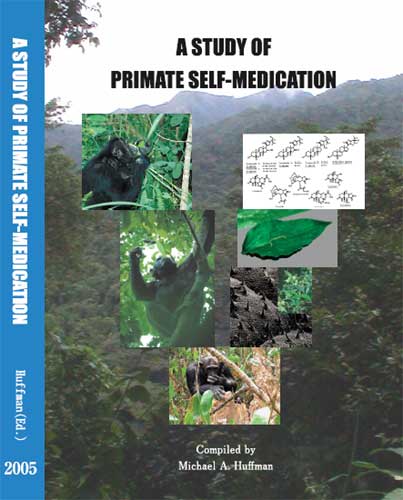

 This volume is dedicated to the memory of Chausiku (ca. 1958
- 1990), my first mentor in chimpanzee self-medication, and
a teacher to many of us who have had the privileged of
sharing time with Mahale chimpanzees. (photo by M.A.
Huffman, Nov. 1987).
This volume is dedicated to the memory of Chausiku (ca. 1958
- 1990), my first mentor in chimpanzee self-medication, and
a teacher to many of us who have had the privileged of
sharing time with Mahale chimpanzees. (photo by M.A.
Huffman, Nov. 1987).

